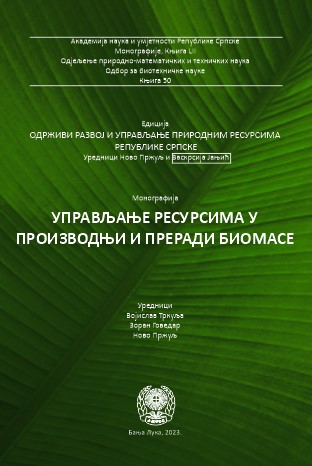Methods of energy production from biomass
DOI:
https://doi.org/10.7251/EORU2306459MKeywords:
Biomass, sustainable energy, technological processes, methods of energy production, directions of further developmentAbstract
Biomass, in addition to being used for heating purposes in households, is increasingly used for the production of electricity, as well as liquid fuels for motor vehicles. Similar to other renewable resources, the analysis of the possibility of using biomass (theoretical, technical and economic potential) should include a systematic analysis of available potentials and technologies, as well as economic parameters related to its price (biomass as raw material), the price of energy obtained from biomass (effectiveness of applied technology of transformation of primary into useful form of energy) and competitiveness in relation to other energy sources (static and dynamic economic-financial parameters). As there are different techniques and methodologies for estimating the potential of biomass, it is possible to significantly deviate from the obtained results in the estimated quantities, so it is necessary to further analyze the acceptability of the error in the assessment. The biggest obstacle in the use of biomass as an energy source for industrial purposes for energy production is the lack of a fuel cycle of a chaos system of processes, technologies and equipment that allow fuel from its natural state (primary form of fuel) to be prepared and brought into a usable state (usable forms of energy). The process of formation and development of the fuel cycle for biomass is further complicated by the diversity of forms and properties of biomass, its wide distribution and low energy concentration, as well as its seasonal character. The potential of biomass in the territory of Republic of Srpska comes from various production activities (residues from field, fruit, vineyard, livestock and forestry production, as well as municipal waste). Farming and animal husbandry have a long tradition among farmers in the Republic of Srpska, as well as fruit, vineyard and forestry production. The structure and quantities of communal waste depend on housing density, economic and communal activities, cultural habits and social environment. Biomass as an energy source is available in the form of waste from forestry and wood processing (waste wood from forestry, sawdust, bark, construction waste, wood packaging, plant residues from fruit production, plant residues from agricultural production - straw, corn, etc.), plantation of energy crops (energy cereals, fast-growing energy tree plantations, sugar-rich plants, oilseeds, etc.), as well as organic waste. The process of conversion of biomass into energy is most often observed from the thermal, i.e., thermo-chemical, biological or physic-chemical process. Within this chapter, an overview of the state and directions of development of technologies for the conversion of biomass as an energy source into a useful form of energy (primarily into electricity and heat) is given. Each method of energy production used, including methods that use biomass as fuel, has its advantages and disadvantages. Special emphasis was given to overcoming significant shortcomings in the use of biomass as an energy resource, as well as its impact on covering the total consumption of electricity and heat and technological steam in industrial plants, as well as consumption as biofuels in transport technology. A special segment is given to the impact of biomass as an energy source on environmental protection, as well as on the conditions that need to be provided in order to achieve CO2 neutrality. Also, the sustainability of each of the methods for the transformation of biomass into a useful form of energy was analyzed.
